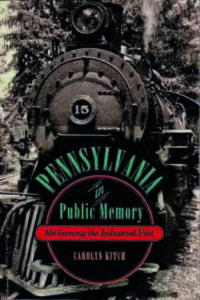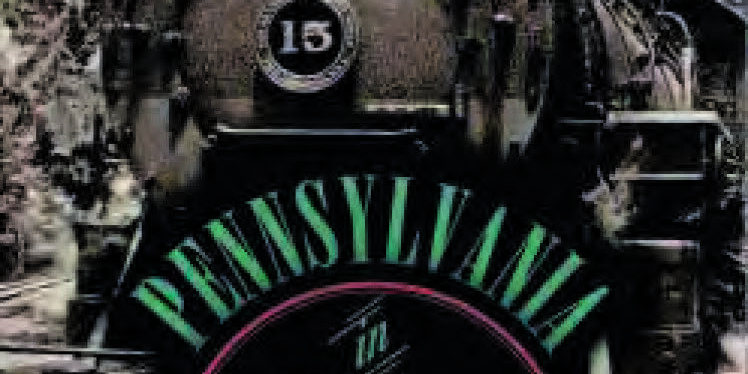Pennsylvania in Public Memory: Reclaiming the Industrial Past
By Carolyn Kitch
University Park: Pennsylvania State University Press, 2012
260 pages, $23.99, Paperback
Reviewed by Harold Aurand Jr.
 Our Statement of Purpose appears inside the front cover of every issue of the SCA Journal: “The purpose of the society is to recognize the unique historical significance of the twentieth-century commercial built environment and cultural landscapes of North America.” That means we focus on stores, hotels, restaurants, gas stations, tourist attractions, and their advertisements and ephemera.
Our Statement of Purpose appears inside the front cover of every issue of the SCA Journal: “The purpose of the society is to recognize the unique historical significance of the twentieth-century commercial built environment and cultural landscapes of North America.” That means we focus on stores, hotels, restaurants, gas stations, tourist attractions, and their advertisements and ephemera.
We have a cousin organization, of sorts, known as the Society for Industrial Archeology. The SIA studies the history of factories, mines, mills, and other places of productive work. While you might think there would be little overlap between the two groups, Carolyn Kitch’s book Pennsylvania in Public Memory: Reclaiming the Industrial Past shows that this isn’t necessarily the case.
The industrial revolution came early to Pennsylvania. Iron production started in the colonial period, coal mining in the early 1800s, and textile mills, food processing, glass, and cement were all significant sources of employment. In the years after World War II, though, everything changed. The coal industry declined as Americans turned to new sources of fuel, and other industries moved production either to other parts of the
U.S. or overseas.
As the companies that had provided jobs for generations of Pennsylvanians disappeared, residents had to look for new economic opportunities. An answer many areas seized on was heritage tourism. Essentially, Pennsylvanians decided to transform the places the SIA studies, into places of interest for the SCA.
Kitch organizes her book based on how industrial sites have been transformed into tourist sites. These examples include closed coal mines that are open for tours, the Pennsylvania Lumber Museum, and still operating factories that are open to the public. She also examines the ethnic diversity of the working-class communities and problems with the heritage tourism industry in general.
One challenge is that in many communities, there are still people who either worked in the now-closed industries or who had family members work there. The heritage developer must be respectful of their experience and what they say about it. At the same time, an attraction must entice tourists and make the past meaningful to current visitors. How much can you commercialize a site and still remain acceptable to those for whom it was a lived experience?
Another challenge is that the stories behind heritage sites are often complex. The reason a mine or factory became a tourist site is that the industry failed. Are the museums memorializing the workers and communities that contributed to the American economy, or are they marketing someone else’s tragedy?
Finally, who gets to decide what stories former industrial sites tell?
These three fundamental questions about heritage tourism result in a wide diversity of sites for the public. Some are commercial successes, like the Crayola Experience in Easton, which attracts large crowds, but says relatively little about the crayon-making process. Other sites have sought success in linking with other attractions as regional heritage routes.
Commercialization has taken a back seat to heritage at a few sites that have focused on local worker experiences. Often these are small house museums or local historical societies, open only a few hours a week and staffed by volunteers. These places seem more interested in keeping their communities connected with their past rather than attracting tourists.
The book’s weakness is that Kitch focuses on sites that have become museums. There are others places that have developed into restaurants, hotels, or bed and breakfasts.
The Lackawanna Railroad Station hotel in Scranton and First Street Station in Northumberland are examples of non-museum commercialization of the industrial past that are described in the book. Still, there is no attempt to do this coherently or as a group. A chapter on how restaurants work to preserve an industrial past, for example, would have been very worthwhile.
As a resident of an area of Pennsylvania that saw massive economic dislocation, I can attest there are many creative reuses of old industrial structures. The new owners consciously try to make a statement about the building’s past, whether they are in the museum business or not.
Harold Aurand Jr., a professor at Penn State-Schuylkill Campus, is surrounded by heritage tourism sites related to anthracite coal mining. If you ever visit the area, though, make sure you stop off for the free Yuengling Brewery Tour. (And yes, they give samples at the end.)
This book review originally appeared in the SCA Journal, Spring 2020, Vol. 38, No. 1. The SCA Journal is a semi-annual publication and a member benefit of the Society for Commercial Archeology.
More Book Reviews


